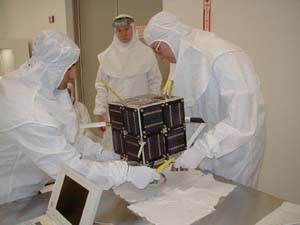Help wanted in the aerospace industry
It’s frightening how little progress has been made
There's little that scares George Muellner, who has bragging rights to 690 combat missions in Vietnam. During three decades in the U.S. Air Force, he accumulated 5,300 hours in the F-4, A-7, F-15, and F-16 as a fighter pilot, fighter weapons instructor, and test pilot. He even flew 50 combat sorties in Operation Desert Storm, and retired from the Air Force in 1998 as a Lieutenant General.
But today, as a Fellow and President of the American Institute of Aeronautics and Astronautics (AIAA), Muellner told a group of journalists, scientists, and aerospace executives at the National Press Club in Washington, D.C., that he's frightened at the lack of progress in three key areas of U.S. aerospace: the energy efficiency of aircraft, reducing their environmental impacts, and replacing an aging workforce. While others spoke on the first two topics, Muellner focused on the workforce issue. "If we don't deal with it," he said, "there could be major, negative long-term impacts."
After leaving the Air Force, Muellner worked for Boeing until last year, where he held several posts including chief of the company's shadowy Phantom Works group. Muellner recalled that, at one point, a quarter of the engineers working for him were old enough to have retired all at once. "They didn't, luckily," he says, and continued working due to a deteriorating economy.
working due to a deteriorating economy.
"How do we bring in younger people?" he asked. Then he attempted to answer his own question, arguing that we need to inspire kids at earlier ages in grammar school to study math and engineering. He lamented the incompetence of teachers, and quoted former Lockheed Martin CEO Norman Augustine, a former AIAA President who also chaired the Aerospace Industries Association and the Defense Science Board, that two-thirds of science teachers and half of math teachers are not qualified to teach kids today. Colleges need to deal with nagging drop-out rates from engineering programs; the best way to accomplish this, says Muellner, is to offer more interesting coursework earlier. "I had my first aero course as a junior, and not until second semester did we run engines," he said. Finally, when these engineers move from college to the real world, he says, the aerospace industry, which loses about 14 percent of its young professionals on average—many of them to Wall Street—needs to keep them interested with rewarding work, solid feedback, and a healthy balance between job and family.
Muellner ended on a positive note, reminding the room that U.S. aerospace ended 2007 with a $60.6 billion positive trade balance. The Aerospace Industries Association reports this to be the largest positive trade balance of any U.S. manufacturing industry.
But today, as a Fellow and President of the American Institute of Aeronautics and Astronautics (AIAA), Muellner told a group of journalists, scientists, and aerospace executives at the National Press Club in Washington, D.C., that he's frightened at the lack of progress in three key areas of U.S. aerospace: the energy efficiency of aircraft, reducing their environmental impacts, and replacing an aging workforce. While others spoke on the first two topics, Muellner focused on the workforce issue. "If we don't deal with it," he said, "there could be major, negative long-term impacts."
After leaving the Air Force, Muellner worked for Boeing until last year, where he held several posts including chief of the company's shadowy Phantom Works group. Muellner recalled that, at one point, a quarter of the engineers working for him were old enough to have retired all at once. "They didn't, luckily," he says, and continued
 working due to a deteriorating economy.
working due to a deteriorating economy."How do we bring in younger people?" he asked. Then he attempted to answer his own question, arguing that we need to inspire kids at earlier ages in grammar school to study math and engineering. He lamented the incompetence of teachers, and quoted former Lockheed Martin CEO Norman Augustine, a former AIAA President who also chaired the Aerospace Industries Association and the Defense Science Board, that two-thirds of science teachers and half of math teachers are not qualified to teach kids today. Colleges need to deal with nagging drop-out rates from engineering programs; the best way to accomplish this, says Muellner, is to offer more interesting coursework earlier. "I had my first aero course as a junior, and not until second semester did we run engines," he said. Finally, when these engineers move from college to the real world, he says, the aerospace industry, which loses about 14 percent of its young professionals on average—many of them to Wall Street—needs to keep them interested with rewarding work, solid feedback, and a healthy balance between job and family.
Muellner ended on a positive note, reminding the room that U.S. aerospace ended 2007 with a $60.6 billion positive trade balance. The Aerospace Industries Association reports this to be the largest positive trade balance of any U.S. manufacturing industry.